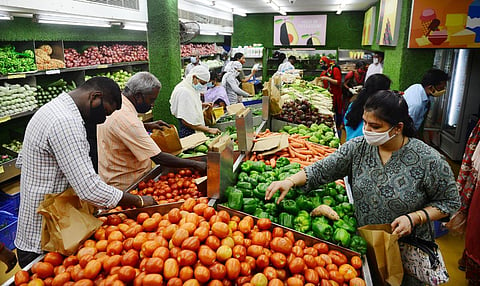

The inflation situation in the country may worsen in coming months due to the ongoing erratic trend in rainfall, Bank of Baroda said in report.
“Cumulative rainfall for the country has slipped in to the deficient zone at 11% below long-period average,” the report said.
It pointed out that the El Nino phenomenon, associated with a warming of sea surface temperature, has resulted in uneven distribution of rains with frequent breaks in August.
“These conditions are expected to intensify further from moderate to strong given the warming up of the tropical pacific, reflected through the SST (Sea Surface Temperature) anomaly. The kharif sowing has been up a tad bit from last year due to erratic rains and patchy distribution of rainfall across different regions. This in turn might translate in to higher inflation in coming months,” Bank of Baroda Economist Jahnavi Prabhakar said in the note.
The country has also reached record levels of electricity demand, at 241 GW compared to peak demand of 212 GW last year.
Kharif Sowing
Prabhakar pointed out that the total kharif sowing has improved by only 0.4% (1,073.2 lakh hectares to 1,077.8 lakh hectares) compared with last year as of September 1, 2023.
But on the positive front, the acreage of rice has improved by 3.7% from last year, she noted. Coarse cereals have grown contributed by higher sowing in Bajra (0.6%) and Maize (2.7%). Sugarcane sowing has also observed a sharp acceleration from 2022.
The factors which have shown a negative growth in sowing area however are pulses(-8.5%), cotton, oil seeds (-0.9%) and Jute & Mesta (-5.7%) respectively compared with last year.
Monsoon
Monsoon plays a significant role in the agricultural output and hence for economic growth. But according to IMD, the monsoon was highly unfavourable in the month of August.
In accord with the analysis, regions in the eastern belt of India including Bihar, Jharkhand, and Chhattisgarh have received only deficient rainfall in the period of June to September this year. Further, states such as Kerala and some states in North East(Manipur, Tripura and Mizoram) also have been witnessing lower rainfall for the same period.
Himachal Pradesh however continues to receive extreme rainfall. The state had also witnessed unprecedented damage to lives and assets due to excessive rains and flash floods earlier this year.
The remaining parts of the country have received normal rainfall.
The actual rainfall this year however continues to be comparatively less than last year (31mm vs 36mm). It is also so far lower than the normal rainfall (50.9mm).
The reservoir level as a percentage of total capacity currently stands at 63% as on 31 August 2023 compared with 82% in the last season.
The total storage available currently in 150 reservoirs stands at 77% of storage last year and 91% of average storage for the last 10 years.
The highest reservoir levels has been registered in the Northern region, with a total of 83% performance. Other regions such as Central (73% vs 77% last year), Western (71% vs 88%) along with Eastern region (48% vs 62%) and Southern region( 49% against 90%) have reservoir levels this year compared with last year.
Meanwhile, the note pointed out that IMD however is expecting a normal monsoon in September 2023.